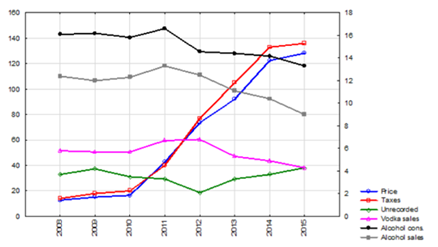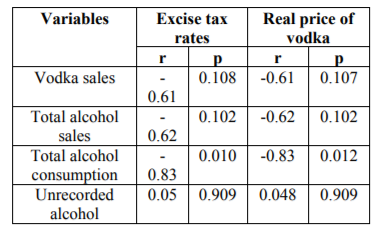Information
Journal Policies
The Effects of Alcohol Tax Increases on Alcohol Consumption in Belarus
Y. E. Razvodovsky
Copyright : © 2018 . This is an open access article distributed under the Creative Commons Attribution License, which permits unrestricted use, distribution, and reproduction in any medium, provided the original work is properly cited.
Background: The majority of aggregate econometric studies indicate that higher taxes and real prices on alcohol significantly reduce the alcohol consumption.
Objectives: To estimate the effects of alcohol tax increases on alcohol consumption in Belarus.
Methods: Trends in the excise tax rates on spirits (vodka), real price of vodka and per capita vodka sales, total alcohol sales, total level of alcohol consumption between 2008 and 2015, were compared.
Results: A Spearman’s correlation analysis suggests an inverse relationship between the excise tax rates on vodka and vodka sales per capita, total alcohol sales, as well as alcohol consumption per capita. The association between the real price of vodka and vodka sales per capita, total alcohol sales, as well as total alcohol consumption was also negative.
Conclusions: The results from this study suggest that in Belarus, consumer demand for alcohol is sensitive to changes in the price of vodka. These findings indicate that pricing policy has potential to reduce harmful drinking in Belarus.
Alcohol Consumption, Alcohol Tax,Addiction
1. Introduction
Alcohol has been suggested to be a crucial factor in the mortality crisis that occurred in Belarus in the post-Soviet period [1-7]. Specifically, high overall alcohol consumption, episodic heavy drinking of spirits (i.e., drinking of large quantities of strong alcohol in a short period of time) and consumption of alcohol surrogates (illegally produced alcoholic beverages and alcohol surrogates) have been linked to excess mortality from acute alcohol poisonings and cardiovascular disease in Belarus during the transition period [8-10].
It was repeatedly emphasized that pricing policy (i.e., reducing the affordability of alcohol) might be the effective intervention to reduce alcohol’s harmful effects [11,12]. There is some evidence that a 2011 policy initiative in Belarus to reduce alcohol-related burden, which included increasing excise taxes on alcohol products, might have had a beneficial effect in terms of reduced mortality [13,14].
In the population survey conducted in Grodno province (Belarus), respondents provided a wide range of differing answers concerning what they would do if there were changes in the affordability of alcohol. In response to an increase in the price of vodka, 29.2% of men and 53.3% of women reported that they would begin to drink less alcohol, while 50.0% of men and 15.3% of women would begin to drink samogon [15,16]. This suggests that pricing policy might be one way to reduce harmful drinking in Belarus, although there was some indication that a high price of legal alcohol might also facilitate a switch to samogon drinking.
Against this background, it would be interesting to estimate the effects of alcohol tax increases on alcohol consumption in Belarus. In relation to this, trends in the excise tax rates on vodka, real price of vodka and per capita vodka sales, total alcohol sales, total level of alcohol consumption between 2008 and 2015, were compared.
2. Methods
The data on vodka sales, total alcohol sales (in liters per capita), excise tax rates on vodka, real retail price of vodka are taken from the Belarusian State Statistical Committee (Belstat) reports. The total level of alcohol consumption (in liters per capita) in Belarus has been estimated using the indirect method based on alcohol psychoses incidence rate [17,18]. To examine the relation between dependent variables (vodka sales, total alcohol sales, total alcohol consumption) and independent variables (excise tax rates on vodka, real retail price of vodka a Spearman’s rank order correlation analysis was performed using the statistical package “Statistica 12. StatSoft”.
The excise tax rates on vodka in Belarus have increased 9.7 times (from 14 to 136 rubles per liter of pure alcohol) and the real price of vodka has increased 10.1 times (from 12.7 to 128.3 rubles per liter) between 2008 and 2015 (Figure1). During the same period per capita vodka sales has decreased by 25.9% (from 5.9 to 4.3 liters), total alcohol sales decreased by 27.4% (from 12.4 to 9.0 liters), total alcohol consumption decreased by 13.3% (from 16.1 to 13.3 liters), while unrecorded alcohol consumption increased by 16.2% (from 3.7 to 4.3 liters).
3. Results
A Spearman’s correlation analysis suggests an inverse relationship between the excise tax rates on vodka and vodka sales per capita, total alcohol sales, as well as alcohol consumption per capita. The association between the real price of vodka and vodka sales per capita, total alcohol sales, as well as total alcohol consumption was also negative (Table 1).
4. Discussion
The results of the analysis suggest an inverse relationship between excise tax rates on alcohol consumption at the aggregate level. A significant increasing in the real price of vodka appears to have been a major driver of substantial decreasing in alcohol sales between 2011 and 2015. These findings are consistent with the principle that increasing the price of alcohol reduces its consumption [11,12].
Empirical evidence suggests that government policies designed to raise prices and restrict availability of legal alcoholic beverages in Belarus have driven black market grows [19]. The results of present study indicate that the recent excise tax and price policy in Belarus made legal alcohol more expensive. The negative outcome of this policy was that the rise in prices for legal alcohol generated a demand for unrecorded alcohol, as it was suggested by the results of the population survey [15].
In conclusion, the results from this study suggest that in Belarus, consumer demand for alcohol is sensitive to changes in the price of vodka. These findings indicate that pricing policy has potential to reduce harmful drinking in Belarus. This study also emphasizes that unrecorded alcohol drinking remains a significant problem in Belarus. Given the comparatively high prevalence of unrecorded alcohol consumption and its potential effect on health, urgent efforts should be made to control the production, distribution and sale of products that can be used as surrogate alcohols as well as to inform the general public in Belarus of the possible dangers associated with drinking these products.
References
- Razvodovsky Y.E., Stickley A. The level and structure of alcohol-related mortality in Grodno, Belarus. Alcoholism 2007; 43(2): 91-103
- Razvodovsky YE. Aggregate level beverage specific effect of alcohol sale on myocardial infarction mortality rate. Adicciones. 2009; 21(3): 229-238.
- Moskalewicz J., Razvodovsky Y.E., Wieczorek P. East-West disparities in alcohol-related harm. Alcoholism and Drug Addiction 2016; 29: 209-222.
- Razvodovsky Y.E. Alcohol attributable mortality in Belarus. Alcoholism. 2012;48(1):13-22.
- Razvodovsky, YE. Alcohol and suicide in Belarus. Psychiatria Danubina. 2009, 21(3): 290-296.
- Razvodovsky, YE. Alcohol related problems in Belarus. Alcologia. 2000;12(1):10-14.
- Razvodovsky, YE. Dynamics of alcohol consumption per capita and different mortality types in Belarus in 1970-1999. Alcologia. 2001;13(1):33-37.
- Stickley A., Razvodovsky Y. Alcohol Poisoning in Belarus: A Comparison of Urban-Rural Trends, 1990-2005. Alcohol Alcoholism. 2009; 44(3): 326-331
- Norström T. Razvodovsky Y.E. Per capita alcohol consumption and alcohol related harm in Belarus, 1970–2005. Eur. J. Public Health. 2010; 20(5): 564-568.
- Stickley A, Razvodovsky Y.E. (2012) The effects of beverage type on homicide rates in Russia, 1970-2005. Drug Alcohol Rev 31: 257-262.
- Razvodovsky Y.E. Affordability of alcohol and alcohol-related mortality in Belarus. Adicciones. 2013;25(2): 156–162.
- Chaloupka FJ, Grossman M, Saffer H. The effects of price on alcohol consumption and alcohol-related problems. Alcohol Res Health. 2002:26(1): 22-34.
- Razvodovsky Y.E. Current alcohol policy in the Republic of Belarus. Questions of Organization and Informatization of Public Health. 2011:3:38-45.
- Razvodovsky Y.E. Alkogolnaya situatsiya v Belarusi v kontekste alkogolnoy politiki. Voprosyi organizatsii i informatizatsii zdravoohraneniya. – 2016. – №1. – S.35–42. (In Russ).
- Razvodovsky Y.E., Stickley A., Koyanagi A. Hazardous drinking among rural residents in Belarus. Journal of Alcoholism and Drug Dependence. 2016; 4(6): 2-5.
- Razvodovsky Y.E. Use of alcohol and surrogates by residents of a typical Belarus city. Alcoholism. 2014; 50(1): 25-34.
- RazvodovskyY.E.Unrecordedalcohol consumption:quantitativemethodsof estimation. Alcoholism. 2010;46(1): 15-24.
- Razvodovsky Y.E. Estimation of the level of alcohol consumption in Russia. ICAP Periodic Review Drinking and Culture. 2013; 8: 6–10.
- Razvodovsky Y.E. Noncommercial alcohol drinking and risk of alcohol-related problems. Jacobs Jornal of Addiction and Therapy. 2015; 2(2): 1-5.






